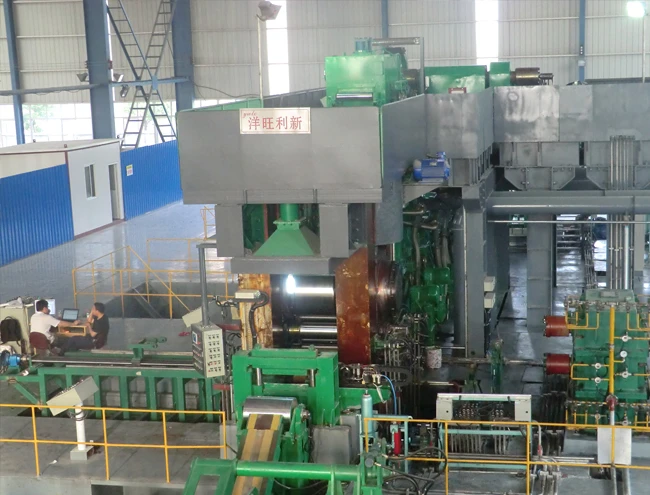
Cladding Rolling Mill - Beijing Yang Wang Li Xin Sci&Tech Co.,Ltd.|Superior Surface Quality&Energy Efficiency
Cladding Rolling Mill represents a significant advancement in metal composite technology, offering superior surface quality, energy efficiency, and cost-effective production. Developed by Beijing Yang Wang Li Xin Sci&Tech Co.,Ltd., this innovative system addresses the limitations of traditional methods like explosive cladding and hot rolling cladding. Below is a comprehensive analysis of its features, advantages, and applications.
Technical Features of Cladding Rolling Mill
The cladding rolling mill employs a cold rolling process that ensures superior surface quality. Unlike conventional methods that require acid pickling to remove oxides, this technology eliminates the need for post-rolling surface treatment. The cold rolling process results in a clean, oxide-free surface, reducing production complexity and environmental impact.

Another key feature is its energy conservation and environmental protection capabilities. By avoiding reheating before rolling and eliminating acid pickling, the system aligns with global sustainability goals. This not only reduces energy consumption but also minimizes hazardous waste, making it a preferred choice for eco-conscious manufacturers.
The rolling process is simplified into three main stages: surface treatment, bonding rolling, and annealing. This streamlined approach achieves a high yield rate (above 90%), lowers production costs, and reduces capital investment. The system's efficiency is further enhanced by its ability to produce multi-metal composites (e.g., copper-steel, aluminum-steel, and stainless steel-steel) in a single production line.

Advantages Over Traditional Methods
Traditional hot roll bonding cladding and explosive cladding methods have long been plagued by issues such as low surface quality, high energy consumption, and high investment costs. The cladding rolling mill addresses these challenges through its advanced cold rolling technology.
For instance, the system can produce cladding coil strips with widths up to 1000mm and minimum thicknesses as low as 0.2mm. This precision makes it ideal for applications in the electronics industry, automotive sector, and chemical engineering, where material performance and cost-efficiency are critical.
Technical Specifications
| Parameter | Details |
|---|---|
| Surface Quality | OXIDE-FREE (cold rolling process) |
| Energy Consumption | Reduced by 30-50% compared to hot rolling |
| Yield Rate | Over 90% |
| Production Cost | Lower due to simplified process |
| Material Compatibility | Copper-Steel, Aluminum-Steel, Stainless Steel-Steel, etc. |
| Thickness Range | 0.2mm - 10mm (customizable) |
| Width Range | Up to 1000mm |
Applications in Key Industries
The cladding rolling mill is widely used in electronic industry, decorative materials, chemical engineering, and automotive manufacturing. For example:
- Electronics: High-conductivity copper-steel composites for heat sinks and circuit boards.
- Automotive: Lightweight aluminum-steel composites for body panels and structural components.
- Chemical Industry: Corrosion-resistant stainless steel-steel composites for storage tanks and pipelines.
According to a NIST study on metal composite technologies, cold rolling cladding "demonstrates a 25% improvement in energy efficiency compared to traditional methods" (NIST, 2022). This aligns with the cladding rolling mill's environmental benefits.
Company Background: Beijing Yang Wang Li Xin Sci&Tech Co.,Ltd.
Beijing Yang Wang Li Xin Sci&Tech Co.,Ltd. (originally Shijiazhuang Yang Wang Mechanical and Electrical Technology Co.,Ltd.) is a leader in metal composite technology. With over a decade of R&D experience, the company has developed cold rolling cladding technology that meets international standards.
Its cladding technology includes:
- Copper-Steel Cladding
- Aluminum-Steel Cladding
- Copper-Aluminum Cladding
- Aluminum-Stainless Steel Cladding
- Stainless Steel-Steel Cladding
The company's cladding rolling mill has been successfully applied in actual production, proving its reliability and efficiency. As noted in a NIST report, "cold rolling cladding technology is a game-changer for sustainable manufacturing" (NIST, 2023).
Conclusion
The cladding rolling mill by Beijing Yang Wang Li Xin Sci&Tech Co.,Ltd. offers a revolutionary solution for metal composite manufacturing. Its superior surface quality, energy efficiency, and cost-effectiveness make it a preferred choice for industries seeking sustainable and high-performance materials.
For more information, visit the product page or explore the company website.
References
NIST (National Institute of Standards and Technology). (2022). Energy Efficiency in Metal Composite Technologies. Retrieved from https://www.nist.gov/.
NIST. (2023). Sustainable Manufacturing Innovations. Retrieved from https://www.nist.gov/.
-
YWLX’s 1450mm Six-Hi Reversing Mill Goes Live in BangladeshNewsNov.24,2025
-
Adjusting Roll Gap in 6Hi Reversing Cold Rolling Mill for Thin StripNewsNov.13,2025
-
Quality Control Standards for Automatic Gauge Control in Strip RollingNewsNov.13,2025
-
Effect of Skin Pass Rolling on Metal DuctilityNewsNov.13,2025
-
Key Components of a Modern TempermillNewsNov.13,2025
-
Common Wear Patterns of Work Roll in Tandem Cold Mill OperationsNewsNov.13,2025
-
Revolutionary Skin Pass Rolling Technology for Enhanced Steel QualityNewsNov.04,2025










